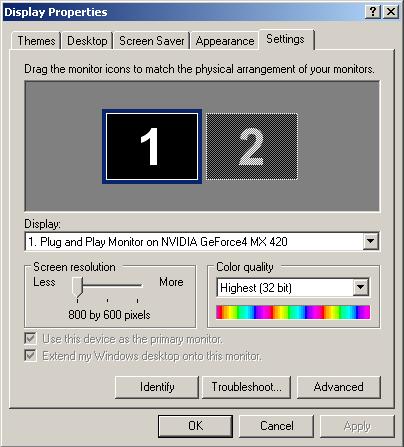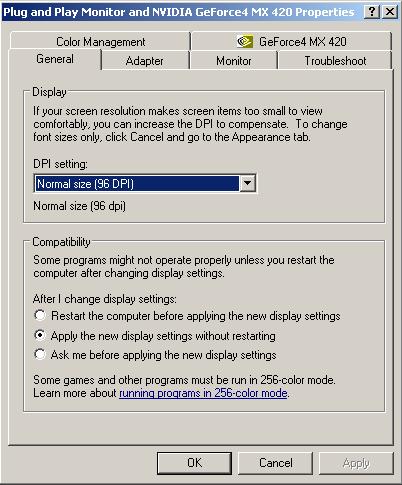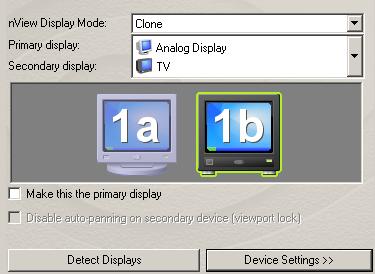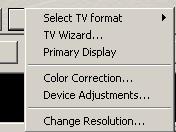You are here: greyghost.mooo.com > Features (or is it Rants?) > Interesting Adventures with nVidia Graphics Cards, Drivers and Their TV Encoder
An Adventure with nVidia Graphics Cards: How to Enable TV Composite Video Output
In case you came here
looking for instructions to configure your nVidia GeForce card's TV
output, you probably want to skip the rantings of this particular
madman and see the facts. If that's you, click here. For everyone else, here we go.
You know, as much as I
like computers, there are times that I also hate them.
And I don't mean “hate”
in the sense of “I don't really like that” or “it's not my
favorite thing”. I mean hate in its purest distilled sense, of
along the lines of “what the heck were the people who designed this
$@#! thing thinking?! Were
they thinking AT ALL? Why the heck doesn't this crap just freakin'
work?”.
Don't get me wrong here. While I like fiddling with computers,
getting something to take shape and work properly and/or finding new or
interesting projects to do with them, there are times that I Just Want
Something To Work right out of the box.
In some ways, I'm starting to care more about the message than the medium as I grow older. I think I'm becoming of those dirty Macintosh users.
(Actually, that is the truth. I parked my PC/Windows 2000 laptop quite
a long time ago.) Sometimes a computer becomes an adventure when you
least want it to do so, with something sinister peeking up over the
hood as you hurtle down the information superhighway, instead of a
means to an end.
I'm
not the first person to travel down this road by a long shot. Tales
of computer related vitriol are far from uncommon. Some people have
even done it much better than I.
Usually
I get to frothing like this at, say, the GNU/Linux operating system,
but I've generally held my tongue because the Linux crowd has its share of
obnoxious (to put it kindly)
people who feel that Linux is The One True Operating System and Has
No Faults. These are sometimes called "COLA nuts", not to be confused with Kola Nuts.) This is something they are rather vocal about, and it does
no good to complain, no matter who you happen to be. (I'm taking this rather far out of context, but it serves the point.)
(That being said, if you are one of those Linux Zealots or a Unix Weenie
reading this and planning to cause trouble, know that I have a huge
amount of respect for what GNU/Linux stands for. I believe very
strongly that free and open software is vitally important to our
society, but I have yet to reach the point where I'd put my mother in
front of a Linux box. I don't give a darn how you think disks should be
enumerated*, I care only about investing a reasonable effort to get my
work done and to know the tools I have to know in order to reach that
goal. But I digress.)
How
I Got Here
A
friend of mine started doing a live music broadcasting show on
the former BlogTV site**, spinning his own records and CDs, and sometimes taking
requests. You know, the kind of thing that's probably illegal
if you squint just right and hop up and down on one leg while
reciting the alphabet diagonally. I have no particular background in
broadcasting and media, but I have a huge imagination. I used to act
on it a lot as a kid and teenager. Now I'm supposed to be an adult or
something so I've dialed it down a bit. I still think having an
imagination and being willing to use it (despite immense pressure to conform and act one's age) is a beautiful thing.
Much
of the stuff I did as a kid was a “one off”...one day I'd be in
the beer business, the next I'd be a farmer, maybe a truck driver, detective, and so on. My dad was
into computers back in the 80s, and I took after him. A bird feeder
box that I'd filled with various toys became my printer, and two
Tupperware boxes became my screen and keyboard. When my mother asked
what I was doing, I told her I was “on CBS”, because for all I
knew at maybe five years of age, you could get to CBS on the
computer. This went on for a week or so until the box that had been
my printer had to go.
Clearly I was something of a futurist back then, because today you can get to CBS on the computer and even watch many of their TV shows if you're so inclined!
(Late 2013 addition: Somehow I totally neglected to talk about the
"printer's" own rather futuristic aspects, in that it could "print" 3D
objects. Usually it produced a plastic wallet I carried at the time,
and made--or rather, I made--dot matrix printer noises while the
"printing" was taking place. Stop looking at me like that.
So, once again, I was quite far ahead of my time with the whole idea of
3D printing. Which is, as of this writing in late 2013, and not to get
too far off the topic, approximately where television was in the late
1940s. But I digress. Maybe that risk of digression is why I didn't
mention it?)
Yet I
would regularly sit down in front of my dad's stereo system and play
my records and tapes while doing some announcing. From where I sat, I
was the DJ at the best darn radio station in the world. I did
eventually stop doing this when I got my own stereo system later on,
but the desire stayed around in latent form. In fact, at around age 10
or so, I turned my room into what was supposed to be a "honky tonk"
club, mainly by virtue of having found a red party light bulb in a
closet somewhere. I've loved music my whole
life, and while I'm nobody's musician, anything to do with music is
usually interesting to me.
To
make a long story at least a little shorter, my interest in playing at being a DJ was
rekindled by said show. I acquired some equipment on a shoestring
budget and decided to see what it would be like to really broadcast.
I did a quick test broadcast and then the real thing. It went pretty
well, though there were some problems.
Along
the way, I came into a 3M “Mincom” Color Bar Generator and used
it on my show. This spurred competition from weasel2htm on his own
show, when he set up a Weatherstar 4000 emulator
and
broadcast with it. Apart from an unfortunate tendency to tell some
people that they have been "banned" from the site (this happened to me
at work), the concept of a Weatherstar 4000 emulator is very cool. No, really. It is. Stop looking at me like that. Sheesh.
I had
to answer this somehow, don't you know? This led to the following
Important Questions:
- How
could I do this cheaply and with stuff I had on hand?
- What
would be the path of least hair loss and stress to accomplish this?
- What
would I display on this contraption once I had it working?
All of
these were easily answered questions, at least the realm of theory
(where sheep are elastic, have a consistent unladen velocity in a
vacuum
and time flows without leap seconds). I'd use a Dell Dimension 4550
with an nVidia GeForce 4MX graphics card having a TV encoder, check
to be sure that the TV output was enabled, and use a combination of
an S-video to composite adapter and a composite video cable with a
length firmly in the “evil” territory. A few hours before my
show, I answered question number three. I'd managed to b0rk the
Weatherstar emulator somewhat in my adventures with it, so I dug up a
forgotten video of my playing Rigs of Rods set to polka music. (Look,
if you were paying me to do this, you'd have a valid point. But
you're not, so quit that snickering and carry on.)
I'd
discovered while playing with the Weatherstar emulator that the only
output I was getting from the S-video to composite adapter was black
and white...at least as far as a color video monitor was concerned
Since the picture was otherwise fine, I decided that was tolerable
after trawling through the nVidia forums appeared to suggest that
nVidia had broken something in the last driver release for this card
(71.89). Some people reported never fixing the problem, while others
had varying amounts of success by reverting back to older or
Microsoft-supplied drivers. There were more who had some luck with
booting into Linux and then going right back to Windows. It seemed
like all of these people were dancing around the problem, instead of
solving it.
As it
turned out, I should have never have asked question #2, or even
thought about it. By doing so, I pretty well sealed my fate.
It's
Ten Minutes Before The Show...
Actually, it was a bit before that when I decided to
move everything into place for this setup. Starting out did not go
well. After plugging the computer into my video switcher, I set the
display to clone mode, launched the Flash Media Encoder preview
window so I could see what was happening and I got nothing.
S-Video
to composite converters are in theory possible, all you have to do is
electrically combine the the separate chroma (color) and luminance
channels to produce composite video. This isn't the right
way to do it, but it usually works.
I
think this was confusing the Fusion 878 IC on my TV tuner card,
because I didn't get simple black and white video. What I got was
mostly dark video, with some dancing colored lines at the top.
“Alright,” said I, “I will show it!” I ran to get an S-Video
cable and hooked that up, all the while daring
the setup not to work. And so it didn't. This was even worse than
what I had.
It
was at this point that the first bad words started to emerge. I
started to rummage in my closet for my scan converter. If that's the
way nVidia wanted to play it, fine. When I didn't find it, I went
looking for anything
that would do what I needed...at first I thought Macintosh and tried
to find the TV output adapter for my Macbook. Failing that, I knew
that I'd seen my Latitude D800's TV breakout cable about a week
prior, but I couldn't find that either. I had twenty minutes left to
get this sorted out, and I really thought about abandoning the whole
thing at this point. By this point, I was thinking that as soon as I
got done with my show, I was going to Break Something, most probably
an nVidia GeForce 4MX video card, with the largest hammer I own.
People die from a lot of different things. It's very
probable that my temper is what will kill me someday, when I've wound
my blood pressure up to the “unwise” level at a point when my
heart just isn't up to it any longer.
So
How Do You Fix This?
You're probably here because you have the same situation
I did...an older nVidia graphics card, Microsoft Windows 2000/XP, a desire to use the TV encoder
output and a wish to use a composite video connection. You've hooked
it up and found that it doesn't work.
Note:
New and currently supported nVidia GPUs will probably be running
drivers that have dropped the classic nVidia settings adjustment
application that was so nicely built into the Windows display control
panel for the newer nVidia Control Panel. I've not been too impressed
with this so-called Control Painel (see what I did there?), but
whatever. It's your only choice now. For now, I'm assuming that you are (or can be) using the
classic approach from the Windows display control panel applet. If
you're not, this procedure won't help you much. So, this
is written mostly for those using the old 71.89 drivers with an older
nVidia GPU.
nVidia has a lovely “TV Wizard” that they include
with their driver software, and you'd think it would ask all the
right questions, but I guess that's just asking too much. The readily
apparent TV options in the software don't really go far enough
either. At least they don't do so in a way that is readily apparent.
Have faith, though, because the settings you need to
adjust are there, only hidden. Open the display control panel and go over to the Settings tab, like this.

Click the Advanced button.

Head
over to the tab that bears the name of your nVidia graphics card. (In
this case, that would be GeForce4 MX 420...) Now you get to see the
nVidia properties for your graphics adapter, including a summary of
what the software thinks is attached to your graphics card. Hopefully
that will include your primary display device and a TV set.

Click
the TV picture so it's highlighted. (Note that if your TV is not
showing up, you may have to do some other configuration. Most TVs are
automatically detected, and even my video switchbox was enough to
satisfy whatever check their software performs. If yours is not, look
up the option to "Force TV detection" elsewhere in the control panel.)
You do, of course, need to make sure that the video card is set to
actually send something to an attached TV set. It matters not if you
choose to clone the primary display, stretch the desktop out to your
TV, or use the so-called "TwinView" feature (which creates a separate
desktop, though some drivers have this feature (artificially) disabled).

Now you can click on "Device Settings". You'll get a pop-out menu.

You could choose to run the TV wizard at this point, but its glitzy and glossy user interface doesn't actually give you the options you need to have. Yay. Point to "Select TV Format" instead. When it pops out, click the "Advanced" button.

This
will summon the "Advanced" properties box. And would you look at
that...a drop down to tell the software just what kind of TV you have
attached...wasn't that easy?

If
needed, you can also opt to perform other adjustments, such as image
centering with this part of the nVidia driver software. Most people
won't need to do anything further, so you can click OK unless you have
some other changes to make. At this point (you might have
to restart--I didn't) you should have something usable showing up on
whatever it is you are handling the TV signal with. You can now close
out of the nVidia control panel pages and all should be working well.
Did this work for you? Tell me.
Go Back >
Copyright © 2011-2012
William
R. Walsh.
All Rights Reserved. Permission is granted to reproduce this material
or to use any part of it in other creations, so long as the following
terms are met: attribution to this page and its author must be
supplied, no part of this page may be displayed along advertising
content of any sort, no fee may be assessed to provide access to this
information (except as reasonably necessary to cover connection time or
printing supply expenses) and no part of this material may be used in
creations that are illegal, dangerous or derogatory. Created
04/06/2011, edited and posted 05/14/2011, updated 11/28/2011, updated again with more rambling on 11/14/2013.
* That particular bit of vitriol is directed at and based upon a
magazine article I once read in some Linux magazine. (It might have
been Linux Journal, but don't hold me to that.) The author of said
article was busily trying to tell us how just how wrong
the DOS and Windows method of enumerating storage devices really was,
something that immediately set off my "why should this even matter?"
alarm. Said person was thoroughly not getting the point--telling me
that your OS is better is not sufficient. Make me a believer. I'm still
confident we'll get there. Someday.
** That is, before it turned into PooNow.